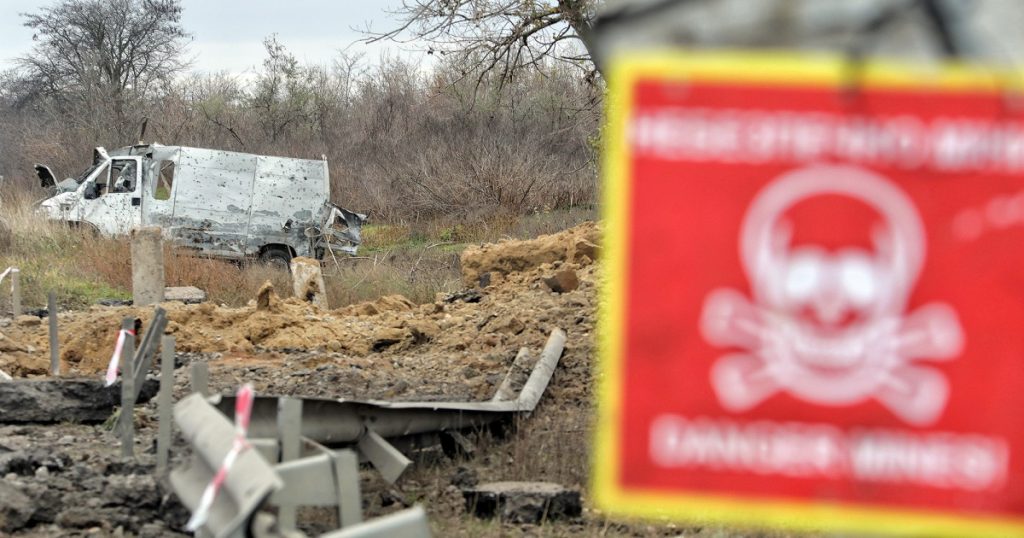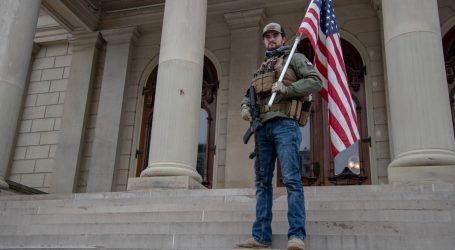“An Abyss of Fear and Wild Lawlessness”
Fight disinformation: Sign up for the free Mother Jones Daily newsletter and follow the news that matters.Signs of the Russian presence linger everywhere in the recently liberated southern Ukrainian city of Kherson. In shops, vendors still sell “Crimea” brand lemonade, made in Russia. Hanging from billboards are exhortations that “Russians and Ukrainians are one people”—old-fashioned propaganda that now seems like grim satire. A smiling grandmother on one billboard extolls Russian social welfare spending as if the matter of accepting occupation were as simple as choosing a toothpaste.
But most of those billboards are now in tatters, torn to shreds by a population eager to purge themselves of anything Russian. Just 20 days after formally annexing Kherson in a lavish ceremony in the Kremlin, Russia’s military announced it was retreating from the city on November 10. Russian forces had been under pressure for months from Ukrainian artillery and had finally decided to get out while they could.
When I arrived four days later, the mood in Kherson was ecstatic. “We were afraid that we would be left as part of Russia,” said 46-year-old Tanya Kopitina, beaming with happiness at the arrival of the Ukrainian army. “Anything but that.” Standing on the city’s central square, I watched hundreds of men, women, and children dressed in their best clothes burst into patriotic chants when Ukrainian President Volodymyr Zelensky appeared during his brief tour of the city. The liberation of Kherson city, the only regional capital taken by Russia, was the “beginning of the end of the war,” Zelensky told reporters at a press conference on the square.
The human cost of Russia’s occupation is staggering—measured in broken lives, death, and massive destruction. A report by Human Rights Watch in July outlined a pattern of detentions, torture, and disappearances in Kherson city and southern Ukraine as a whole. They discovered 42 cases in which Russian authorities kidnapped civilians, with many of those civilians describing torture. Some were involved with resisting Russian rule. Others were kidnapped for reasons they could not explain.
Retreating Russian soldiers scrawled “We’ll be back soon” on the wall of a school basement in Velyka Oleksandrivka, a town in Ukraine’s Kherson region.
Sam SkoveRussia’s occupation turned the area into “an abyss of fear and wild lawlessness,” said Yulia Gorbunova, a senior Ukraine researcher cited in the report. Ukrainian human rights ombudsman Dmytro Lubinets said that the magnitude of torture in the Kherson region is unlike anything he had ever seen, despite having visited other liberated areas where Russia practiced imprisonment and torture. “The scale is simply terrible,“ he said, estimating that torture victims numbered in the thousands.
Two weeks before the liberation of Kherson city, I traveled to two recently liberated settlements in the region to better understand what had taken place during the Russian occupation. The settlements, Velyka Oleksandrivka and Arkhanhelske, had been freed by Ukraine’s army in tough fighting on October 3. Although I had previously covered the myriad cruelties of Russian occupation, I was shocked by what I found. At the same time, I saw how ordinary Ukrainians, despite the risks and their own lack of any training, had met the onslaught, claiming their own page in the history books.
The region of Kherson is a vast agricultural expanse of steppe cut through by the wide Dnipro river, which feeds into the Black Sea. Its million residents are among the poorest in Ukraine, with the region’s GDP ranked 24th out of Ukraine’s 26 regions. Just to its south is Crimea, which Russia captured and annexed 2014. Many who live there have close ties with Russia. Before the war, around 45 percent of southern Ukrainians viewed Russia positively.
Russia overran Ukraine’s forces in Kherson within days of its February invasion of Ukraine, and then instituted nine long months of occupation—from March to November. Russia appointed local collaborators to run the government, abolished teaching in the Ukrainian language, and unleashed its security services on any Ukrainians who resisted.
Unsurprisingly, any goodwill Russia had in the region disappeared. Days into the occupation, thousands of residents of Kherson marched in protest. They continued doing so till April. By May, Ukrainian polling showed that only 1 percent of southern Ukrainians still had favorable views of Russia, down from the 45 percent of those polled pre-war. As Russia’s repressive measures silenced protest, some even turned to the ultimate act of resistance by helping the Ukrainian military.
The small town of Velyka Oleksandrivka and the nearby village of Arkhanhelske are farming communities located around a two-and-a-half-hour drive from the city of Kherson. Like many such communities across Ukraine, they’re a mishmash of old-fashioned village homes and Soviet-built government buildings. Velyka Oleksandrivka had 25,000 residents before the war, while tiny Arkhanhelske had around 2,000.
Russian troops overran the communities in March, and for eight months, people lived under Russian occupation. Everyone with whom I spoke described the lawlessness with which the Russian soldiers behaved, suggesting that it was just as deadly as the professional cruelty of the intelligence agents.
A bust of Lenin in the home of Volodymyr Dudnychenko. Sam SkoveIn Arkhanhelske, one house stood out among the sea of modest one-story peasant homes. Surrounded by a high yellow wall, its metal gate was sturdy and large. Past the gate, I found an elegant structure with multiple outbuildings. The gardens extended for yards and yards, filled with roses and rosemary.
The scent of rosemary, it turned out, would be helpful in suppressing my gag reflex. The owners of the home, Valentin and Larisa Pavlenko, had been murdered just over two months before I arrived, most likely by Russian soldiers. Walking around the many outbuildings, I found a narrow staircase leading down into a basement. Distinctly out of place was an enormous splash of blood against the wall. Having never seen a murder scene before, I first thought that it was paint.
The smell told me otherwise. The pungent sweet and sour order of decomposed flesh was inescapable. A neighbor, Nikolai Anferovich, said he found Valentin shot and Larisa with her head bashed in, her body lying under the mattress I was now looking at. The couple had been living there to escape the shellfire that raked the village.
It’s unclear why they were murdered. One resident, Antonina Boitseshko, observed that they had been hostile to the Russians and guessed that a fatal argument may have taken place.
But they were not the only couple to be murdered. Just across from their flower-filled backyard stood a two-story building with a perfect view of the house. When I entered the building, my boots crunched on the debris left by an artillery strike. I climbed the stairs up to an apartment where another couple had been killed. Mykola Melatenko, a retiree, had been found on the balcony, according to seventy-four-year-old Serhiy, who was his neighbor. Melatenko’s wife, Tanya, was shot in the kitchen. Serihy believed they had been killed because Mykola had seen Russians raiding nearby abandoned flats. “They were stealing, he was watching,” he said. “So they killed them.” As in the Pavlenko house, the smell was nauseating and overpowering. I wondered if the same Russians were responsible.
Other cruelties were more precise, aimed at crushing resistance and using brutal psychological tricks to break the Russians’ victims. At the top of the list appeared to be current and former members of the Ukrainian military. Four people with whom I spoke in Kherson said close friends or family members were arrested for their past military service. Others were arrested for displaying pro-Ukrainian sentiment: residents of the nearby village of Kachkarovka told me about men who were jailed for yelling patriotic slogans.
The story of one family in Velyka Oleksandrivka can almost be considered a microcosm of what took place in this community.
Tall and lanky, Volodymyr Dudnychenko is a former soldier who fought Russian-backed separatists in eastern Ukraine in 2015. He’s an active man. By profession an arborist, he founded an association of veterans and earned two university degrees. With evident pride, he showed me a small riverside beach he’d built near his tidy blue cottage. We met on his fifty-fifth birthday outside his home, where he treated me to a shot of homemade alcohol to celebrate the occasion.
While deployed to eastern Ukraine, he met and fell in love with Anya Kotova, a stylish, 36-year-old former accountant with auburn-streaked brown hair. Due to their age difference, he eventually traveled to meet her father and ask for her hand in marriage.
They lived in comfort and prosperity in Dudnychenko’s home in Velyka Oleksandrivka. Kotova became friends with Dudnychenko’s daughter from his first marriage, a 30-year-old also named Anya, and found employment as a manicurist.
When the Russian invasion broke this tranquil life, Kotova and Dudnychenko met it with defiance. On March 9, only days after Russian troops rolled into town, he acquired explosives from a Ukrainian major at a military commissioning office in Ukrainian-held territory. Anya then worked to track a Russian military column, instructing Volodymyr where to lay the explosives. The first armored vehicle, known as a BTR, rolled right past without any damage. The second, which carried as many as 11 Russian soldiers, exploded.
Days later, Kotova, a friend, and her husband’s daughter from his first marriage organized protests against the Russian occupation authorities. “We felt more anger than fear,” said Dudnychenko’s daughter Anya. Local authorities pressured them to cancel it, but they forged ahead. The protests, held on March 13 and 14, were a success. A picture from the protests shows the couple and his daughter striding at the head of a crowd of people, the bright sun shining on the blue and yellow of the Ukrainian flags.
The Ukrainian flag flying on top of the recaptured Kherson Oblast State Administration in Kherson, November 20, 2022. Sam SkoveThis was just the beginning of their resistance activities. Over the following months, Kotova and Dudnychenko evacuated civilians to Ukrainian-held territory, dodging Russian army checkpoints by taking long, circuitous routes. Dudnychenko also worked secretly for Ukraine’s intelligence agency, the SBU. After Russian soldiers asked him to buy them Ukrainian SIM cards, he passed on the numbers to the SBU, which made it possible for them to tap the Russians’ phones.
Dudnychenko took these risks as scrutiny of him increased. In April he was arrested and taken to a Russian detention center, where he was interrogated about his work in evacuating civilians. Fearing execution, he told them what he considered harmless information, such as the number of Ukrainian soldiers typically stationed at a checkpoint. He was released in late April. In May, his wife moved to Ukrainian-held territory to take care of her sick father.
Amid increasing Ukrainian strikes on Russian positions in the town, the Russians turned up the pressure on Dudnychenko. They arrested him twice between May and July. His first detention was relatively mild. He was accused of providing the Ukrainian army with Russian army locations and was subsequently held in a local commandeered house. He was allowed to leave occasionally, however, to give pain medication shots to his cancer-stricken mother.
The second time the Russians came, it was to hurt him. While I have interviewed many Ukrainians who had been detained by the Russian military, Dudnychenko’s experience was perhaps the worst I’d ever heard of in my travels around Ukraine.
At the end of July, after a Russian vehicle on his street was destroyed in a Ukrainian army strike, Russian soldiers surrounded his house. A Russian officer entered his home and knocked him to the floor. The officer, who went by the callsign of Shadow, told Dudnychenko to dig a hole. Once it was done, Shadow asked if he had any last wishes. Dudnychenko asked for a cigarette. “We don’t smoke,” Shadow answered. “Count to five.” When Dudnychenko did, he heard the Russian’s pistol roar. Shadow had shot over his head.
From left to right, Russian billboards in Kherson advertising the fraudulent September referendum on annexation by Russia and a billboard claiming “Russians and Ukrainians, one people, a united whole.” Sam SkoveIt wasn’t over. Standing Dudnychenko up against the wall, Shadow aimed an AK-47 machine gun at him. Shadow fired. Again, the shots didn’t hit him, only smacking into the blue plaster of his neatly kept cottage. The remains of one of the bullets appeared to still be lodged in the wall when I visited—my pen just barely too wide to dig it out. They then placed a bucket over his head, electrocuted him, and brought him back to consciousness by beating him. Eventually, Dudnychenko was dragged to the basement of a local house used as a prison.
Shadow appears to have had a penchant for mock executions and psychological games. At some point, while Dudnychenko was in prison, Shadow gave him a pistol and instructed him to play Russian roulette. Dudnychenko pulled the trigger six times, but the gun never fired. “Your call sign would be ‘Lucky’ if you were serving with us,” Shadow told him.
At some point during Dudnychenko’s imprisonment, the Russians found his wife’s name in his phone and called her. Kotova decided to return to the occupied town. It’s unclear what she could have done, but it’s easy enough to imagine her both panicked and determined.
She would never meet her husband again. On August 1, Russian forces inexplicably fired on the bus that Kotova was traveling in. She and four other passengers were killed. “She was such a good person,” Dudnychenko told me, his voice slightly shaking slightly. He was eventually released several days later.
Dudnychenko is now a shadow of his former self. In a photo, he sits on a park bench with his young wife, his open-necked black polo stretched over a small belly. When I met him in late October, he had lost a considerable amount of weight, and his face was deeply lined. The only thing left of the man in the photograph was his smile, a broad, eye-crinkling grin that emerged when he cuddled his two small dogs.
I called him the day after the Russians left Kherson city, and asked how he felt about the news. “Good,” he said in a noncommittal tone. The Russians may have left, but by killing Kotova, they had taken something from him that could never return.
Against the backdrop of grinding Russian violence, though, there was a steady thrum of Ukrainian resistance. At times, it seemed like everyone I met covertly provided information to the Ukrainian army. These novice intelligence agents came from all walks of life, including a roofer, a park director, and an elderly woman who had evaded Russian checks by using an old-flip phone rather than a smartphone.
Two men stood out, though, both for the scale of their work and the modesty of their backgrounds.
Anatoliy Maistrenko smoking a cigarette in Arkhanhelske.
Sam SkoveAnatoliy Maistrenko and Viktor Lifshitz, who worked in the same village where I found the bloodstains from the murdered couples, helped evacuate hundreds of Ukrainians while bringing in Ukrainian special forces teams.
The two do not present as bold, dashing, central-casting heroes out of central casting. Maistrenko, a former tractor driver, is 63 years old, his bushy eyebrows and flat cap a perfect fit for small-town Ukraine. Lifshitz, a short man with a worn face and crooked fingers, stood shyly throughout our interview, embarrassed at first to have his name quoted. Both spoke in Surzhyk, the hybrid of Ukrainian and Russian words found in Ukraine’s border regions that are often perceived as less refined than speaking pure Ukrainian or pure Russian.
I met Lifshitz after Maistrenko walked me over to a section of the riverbank in Arkhanhelske on a sunny day in late October. Lifshitz, rowing the oars on a rubber boat, crossed over from his house in the even smaller village on the other side called Zarechnoye, or “over the river.”
This anonymous piece of land was where the two had ferried hundreds of locals out of Russian occupation and into freedom. Crossing to Arkhanhelske from nearby towns and villages, Ukrainians of all ages and professions entrusted themselves to Maistrenko, Lifshitz, and a man named Valeriy to row them the nine miles to a point in Ukrainian-held territory. The three kept a tally of the number of people they helped cross—but they stopped counting after 1,483. The youngest was a month old, Maistrenko said. The oldest was 95.
But some of the people they ferried were looking to enter Russian-held territory, not escape it. Rowing at night, the three men also brought in Ukrainian special forces teams to raid occupied areas, killing Russian soldiers and collecting intelligence. In order to contact the boatmen, one of the Ukrainian soldiers would dress as a trash collector and come by Lifshitz’s house in Ukrainian-held Zarechnoye. When his wife said to take out the trash, Lifshitz knew he had work.
When I asked Lifshitz if he was afraid, he was noncommittal. “I always had a grenade in my pocket,” he said. Maistrenko was more candid. “We were afraid, of course,” he said. “But if we didn’t do it, who would?”





